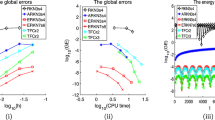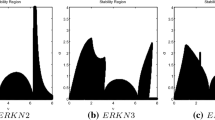Abstract
This paper proposes and investigates the multidimensional extended Runge-Kutta-Nyström (ERKN) methods for the general second-order oscillatory system y″ + My = f(y, y′) where M is a positive semi-definite matrix containing implicitly the frequencies of the problem. The work forms a natural generalization of our previous work on ERKN methods for the special system y″ + My = f(y) (H. Yang et al. Extended RKN-type methods for numerical integration of perturbed oscillators, Comput. Phys. Comm. 180 (2009) 1777–1794 and X. Wu et al., ERKN integrators for systems of oscillatory second-order differential equations, Comput. Phys. Comm. 181 (2010) 1873–1887). The new ERKN methods, with coefficients depending on the frequency matrix M, incorporate the special structure of the equation brought by the term My into both internal stages and updates. In order to derive the order conditions for the ERKN methods, an extended Nyström tree (EN-tree) theory is established. The results of numerical experiments show that the new ERKN methods are more efficient than the general-purpose RK methods and the adapted RKN methods with the same algebraic order in the literature.
Similar content being viewed by others
References
Aubry, A., Chartier, P.: Pseudo-symplectic Runge-Kutta methods. BIT. 38, 439–461 (1998).
Avdyushev, V. A.: Special perturbation theory methods in celestial mechanics, I. Principles for the construction and substantiation of the application. Russ. Phys. J. 49, 1344–1353 (2006).
Franco, J. M.: Runge-Kutta-Nyström methods adapted to the numerical integration of perturbed oscillators. Comput. Phys. Comm. 147, 770–787 (2002).
García-Alonso, F., Reyes, J., Ferrádiz, J., Vigo-Aguiar, J.: Accurate numerical integration of perturbed oscillatory systems in two frequencies. ACM Trans. Math. Softw. 36, 21–34 (2009).
López, D. J., Martín, P.: A numerical method for the integration of perturbed linear problems. Appl. Math. Comput. 96, 65–73 (1998).
Ramos, H., Vigo-Aguiar, J.: Variable-stepsize Chebyshev-type methods for the integration of second-order I.V.P.s. J. Comput. Appl. Math. 204, 102–113 (2007).
Jordan, D. W., Smith, P.: Nonlinear ordinary differential equations, 4th edn. An introduction for scientists and engineers. Oxford University Press, Oxford, (2007)
Wu, X., You, X., Li, J.: Note on derivation of order conditions for ARKN methods for perturbed oscillator. Comput. Phys. Comm. 180, 1545–1549 (2009).
Wu, X., You, X., Xia, J.: Order conditions for ARKN methods solving oscillatory systems. Comput. Phys. Comm. 180, 2250–2257 (2009).
Wu, X., Wang, B.: Multidimensional adapted Runge-Kutta-Nystrom methods for oscillatory systems. Comput. Phys. Comm. 181, 1955–1962 (2010).
Yang, H., Wu, X., You, X., Fang, Y.: Extended RKN-type methods for numerical integration of perturbed oscillators. Comput. Phys. Comm. 180, 1777–1794 (2009).
Wu, X., You, X., Shi, W., Wang, B.: ERKN integrators for systems of oscillatory secondorder differential equations. Comput. Phys. Comm. 181, 1873–1887 (2010).
Wu, X., You, X., Wang, B.: Structure-Preserving Algorithms for Oscillatory Differential Equations. Springer-Verlag, Berlin, Heidelberg (2013).
Hairer, E., Nørsett, S. P., Wanner, G.: Solving Ordinary Differential Equations I: Nonstiff Problem. Springer-Verlag, Berlin, Heidelberg (1993).
Butcher, J. C.: The Numerical Analysis of Ordinary Differential Equations, 2nd edn. Wiley, New York, (2008).
Johnson, W. P.: The curious history of Faà di Bruno’s Formula. Math. Assoc. Am. 109, 217–234 (2002).
González, A. B., Martín, P., Farto, J. M.: A new family of Runge-Kutta type methods for the numerical integration of perturbed oscillators. Numer. Math. 82, 635–646 (1999).
Weinberger, H. F.: A First Course in Partial Differential Equations with Complex Variables and Transform Methods. Dover Publications Inc., New York (1965).
Franco, J. M.: New methods for oscillatory systems based on ARKN methods. Appl. Numer. Math. 56, 1040–1053 (2006).
Author information
Authors and Affiliations
Corresponding author
Additional information
This research was in part supported by NSF of China (No. 11171155, No. 11271186, No. 11101357), the Fundamental Research Fund for the Central Universities (No. Y0201100265), the Research Fund for the Doctoral Program of Higher Education (No. 20100091110033), the foundation of Shangdong Outstanding Young Scientists Award Project (No. BS2010SF031), the foundation of Scientific Research Project of Shangdong Universities (No. J11LG69), NSF of Shandong Province, China (No. ZR2011AL006) and Talented Faculty Fund of Nanjing Institute of Technology (No. YKJ201114).
Rights and permissions
About this article
Cite this article
You, X., Zhao, J., Yang, H. et al. Order conditions for RKN methods solving general second-order oscillatory systems. Numer Algor 66, 147–176 (2014). https://doi.org/10.1007/s11075-013-9728-5
Received:
Accepted:
Published:
Issue Date:
DOI: https://doi.org/10.1007/s11075-013-9728-5
Keywords
- Extended Runge-Kutta-Nyström type methods
- Extended Nyström trees
- Order conditions
- Second-orderoscillatory systems




